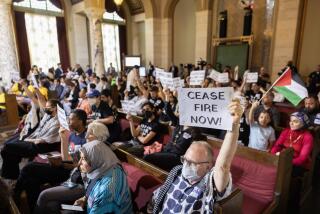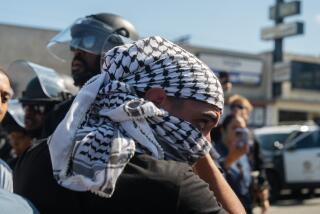Bradley Says Council’s Restrictions on Mosque Are Outrageous : Architecture: The mayor’s support fuels Muslims’ hopes that a dome and minaret can be added to the Northridge building’s design.
- Share via
Mayor Tom Bradley on Monday strongly criticized the City Council for requiring that a proposed mosque in Granada Hills be cloaked in Spanish-style architecture, calling the requirement “outrageous” and “an affront to religious freedom.”
The mayor’s statement encouraged the head of the mosque’s congregation to hope that the city will relent and grant permission to add “a small dome and minaret” to the proposed structure on a 2.5-acre site near Rinaldi Street and Encino Avenue.
Bradley, traveling in Germany on a trade mission, said in a press release and letter released Monday that he wanted his Cultural Affairs Commission to hold a hearing within 45 days that “will lead to development of a city policy regarding the design of religious buildings.”
A construction permit for the mosque had been opposed by some neighboring homeowners. The conditional use permit approved by the City Council last week includes a condition that the final design for the mosque conform substantially to drawings depicting a Spanish-style building with stucco walls and a red tile roof.
The council requirement “displays a lack of understanding of the connection between worship and the architecture and design properties of houses of worship,” Bradley said. “This affront to religious freedom cannot be condoned.”
“I hope it will help us that the mayor’s taking an interest,” said Mohammed Mohuiddin, president of the Islamic Center of Northridge, who heads the Muslim congregation.
With the mayor’s support, Mohuiddin said, perhaps the congregation can obtain city permission to add “a small dome and minaret” to the building. “It would make us feel good to have it look like a mosque, not like a warehouse.”
Deputy Mayor Mark Fabiani said however that the mayor was “not sure he has any legal force to change” the design limits.
“We are primarily looking to the future,” Fabiani said. He described the mayor as “very troubled” by the implications of the council’s action. “If you tell a mosque what to look like, then you can tell a Jewish temple or a Catholic Church. It’s a really slippery slope.”
Councilman Hal Bernson, who represents Granada Hills, could not be reached for comment. His press deputy said he was out of town but would return today. Bernson originally had opposed the mosque but later assured local homeowner foes that the Muslims would be good neighbors.
The Granada Hills edifice, costing $1.8 million and set to be completed in a year, would be the San Fernando Valley’s first mosque, Mohuiddin said. The Valley is home to a growing number of Muslims, he said.
The origin of the mosque’s Spanish-style design was not clear.
Mohuiddin said it was his recollection that the Spanish style was imposed by the area’s Citizens Advisory Committee. These committees, picked by Bernson, are widely believed to reflect his views.
“We didn’t really protest at the time” about the design, Mohuiddin said. “We were really desperate for a place to worship.”
But ex-Councilman Robert Wilkinson, the Islamic Center’s City Hall lobbyist, said he recommended that the congregation adopt the Spanish style to avoid a confrontation with the surrounding neighborhood.
“I advised them to make it blend in with the community,” Wilkinson said. “I told them not to be different.”
The lobbyist said his advice was based on the Muslims’ experience when they “tested the waters” for building a mosque with domes and minarets in a neighborhood near Cal State Northridge.
“The community came unglued,” Wilkinson said. “They were objecting to the way it looked.”
Wilkinson also said that, if Bradley was concerned about hardships imposed by City Hall on the Muslims, the mayor “should not be pointing the finger at the council or the zoning administrator” but at his own Board of Zoning Appeals commissioners.
“The restriction that really hurt was on the size of the congregation,” he said.
The board, whose five members are Bradley appointees, recommended limiting the congregation to 250 worshipers, 300 fewer than the Muslims had originally sought and 50 fewer than the city’s zoning administrator had recommended. The 250-worshiper limit also was approved by the City Council. After a year, this limit can be raised to a maximum of 400, with the approval of a city planning official.
More to Read
Sign up for Essential California
The most important California stories and recommendations in your inbox every morning.
You may occasionally receive promotional content from the Los Angeles Times.













